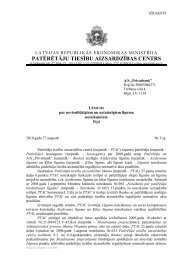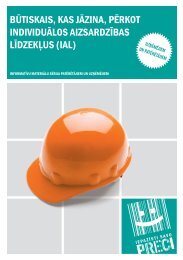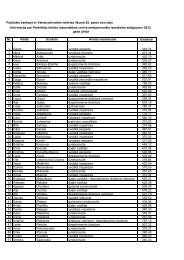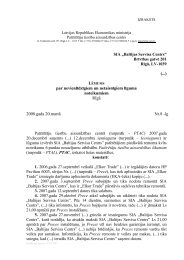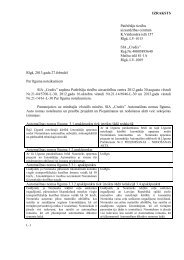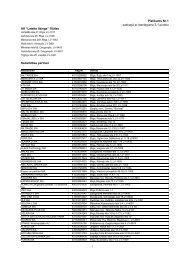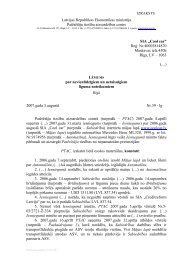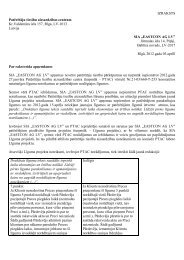safety guidelines on personal protective equipment [ppe]
safety guidelines on personal protective equipment [ppe]
safety guidelines on personal protective equipment [ppe]
Create successful ePaper yourself
Turn your PDF publications into a flip-book with our unique Google optimized e-Paper software.
SAFETY GUIDELINES ON PERSONAL PROTECTIVE EQUIPMENT [PPE]INTRODUCTION AND BACKGROUNDThe EC Directive 89/686/EEC <strong>on</strong> the approximati<strong>on</strong> of the laws of Member States relating to pers<strong>on</strong>al <strong>protective</strong> <strong>equipment</strong> was adopted by the Council <strong>on</strong> 21December 1989.Failure to comply with these Regulati<strong>on</strong>s may mean that PPE may be prohibited from being placed <strong>on</strong> the Community /European Ec<strong>on</strong>omic Area (EEA)*market. If previously placed <strong>on</strong> the market and n<strong>on</strong>-compliant, PPE may be forfeited. PPE complying with the PPE Directive’s requirements may be suppliedanywhere in the EEA.‘New Approach’ Directives (that is Community laws) set out ‘essential requirements’ (for <str<strong>on</strong>g>safety</str<strong>on</strong>g>, for example), written in general terms, which must be metbefore products may be supplied in the Community. European harm<strong>on</strong>ised standards then fill in the detail. C<strong>on</strong>formity with such standards is the main way forbusinesses to comply with the ‘essential requirements’. The Directives also say how manufacturers are to show that products meet the ‘essential requirements’.Products meeting these requirements carry CE marking, which means that they can be sold anywhere in the Community.APPLICATIONThe law applies to any device or appliance designed to be worn or held by an individual for protecti<strong>on</strong> against<strong>on</strong>e or more health and <str<strong>on</strong>g>safety</str<strong>on</strong>g> hazards."This publicati<strong>on</strong> has been produced with the assistance of the European Uni<strong>on</strong>. The c<strong>on</strong>tents of this publicati<strong>on</strong> are the sole resp<strong>on</strong>sibility of PTAC and can in no way be taken toreflect the views of the European Uni<strong>on</strong>."1
EXAMPLES OF PPE PRODUCTS COVEREDSafety helmets Respirators Ear defenders Welding masksKnee pads Face masks Protective footwear Protective gloves2 "This publicati<strong>on</strong> has been produced with the assistance of the European Uni<strong>on</strong>. The c<strong>on</strong>tents of this publicati<strong>on</strong> are the sole resp<strong>on</strong>sibility of PTAC and can in no way be taken toreflect the views of the European Uni<strong>on</strong>."
LATVIAN LAWThe <str<strong>on</strong>g>safety</str<strong>on</strong>g> of pers<strong>on</strong>al <strong>protective</strong> <strong>equipment</strong> is c<strong>on</strong>trolled in Latvia by the following legislati<strong>on</strong>:• C<strong>on</strong>sumer Rights Protecti<strong>on</strong> Law, 1999• Law <strong>on</strong> the Safety of Goods and Services, 2004• Cabinet Regulati<strong>on</strong> o 74 – Requirements for Pers<strong>on</strong>al Protective Equipment, C<strong>on</strong>formity Assessment and Market Surveillance, adopted 11 thFeb 2003This legislati<strong>on</strong> has transposed the requirements of the relevant European Directive into Latvian law. Producers, importers, distributors and suppliers mustensure that they comply fully with the provisi<strong>on</strong>s of their nati<strong>on</strong>al legislati<strong>on</strong>.EU DIRECTIVEDefiniti<strong>on</strong> of PPEPPE means any device or appliance designed to be worn or held by an individual for protecti<strong>on</strong> against <strong>on</strong>e or more health and <str<strong>on</strong>g>safety</str<strong>on</strong>g> hazards.PPE also includes:• a unit c<strong>on</strong>stituted by several devices or appliances which have been integrally combined by the manufacturer for the protecti<strong>on</strong> of an individual against<strong>on</strong>e or more potentially simultaneous risks;• a <strong>protective</strong> device or appliance combined, separably or inseparably, with pers<strong>on</strong>al n<strong>on</strong>-<strong>protective</strong> <strong>equipment</strong> worn or held by an individual for theexecuti<strong>on</strong> of a specific activity;• interchangeable PPE comp<strong>on</strong>ents which are essential to its satisfactory functi<strong>on</strong>ing and used exclusively for such <strong>equipment</strong>.Any system placed <strong>on</strong> the market in c<strong>on</strong>juncti<strong>on</strong> with PPE for its c<strong>on</strong>necti<strong>on</strong> to another external, additi<strong>on</strong>al device is to be regarded as an integral part of that<strong>equipment</strong> even if the system is not intended to be worn or held permanently by the user for the entire period of risk exposure.Exclusi<strong>on</strong>s• PPE manufactured for use in a country outside the Community, or imported into the Community for re-export to a country outside the Community.• N<strong>on</strong>-compliant PPE for presentati<strong>on</strong> at trade fairs, exhibiti<strong>on</strong>s and the like, provided that an appropriate notice is displayed drawing attenti<strong>on</strong> to the factthat-oothe PPE is not in c<strong>on</strong>formity with the provisi<strong>on</strong>s of the Directive; andit may not be acquired or used until it has been brought into c<strong>on</strong>formity by the manufacturer or his authorised representative established in theCommunity."This publicati<strong>on</strong> has been produced with the assistance of the European Uni<strong>on</strong>. The c<strong>on</strong>tents of this publicati<strong>on</strong> are the sole resp<strong>on</strong>sibility of PTAC and can in no way be taken toreflect the views of the European Uni<strong>on</strong>."3
• PPE designed and manufactured specifically for use by the armed forces or in the maintenance of law and order (helmets)• PPE for self-defence (e.g. aerosol canisters, pers<strong>on</strong>al deterrent weap<strong>on</strong>s etc).• PPE designed and manufactured for private use against adverse weather; damp and water; and heat.• PPE intended for the protecti<strong>on</strong> or rescue of pers<strong>on</strong>s <strong>on</strong> vessels or aircraft, not worn all the time.• Helmets and visors intended for users of two or three-wheeled motor vehicles.• Sec<strong>on</strong>d-hand PPE, except for that which, since its last use, has been subjected to further manufacture or refurbished and resold as new PPE.HARMONISED STANDARDSEuropean harm<strong>on</strong>ised standards are European standards outlining technical specificati<strong>on</strong>s which are adopted by CEN and thus through agreement by allmembers. The references of these are required to be published in the Official Journal of the European Uni<strong>on</strong> in order to provide for a presumpti<strong>on</strong> ofc<strong>on</strong>formity.PRODUCT CATEGORISATIONThe Directive provides exclusive lists of ‘simple’ and ‘complex’ design PPE. The resp<strong>on</strong>sibility for deciding whether a product is covered by the Directive and ifso, to which category that PPE bel<strong>on</strong>gs rests with the manufacturer or his authorised representative in the Community.‘SIMPLE’ DESIGN PPEThe Directive defines ‘simple PPE’ (Category I PPE) as PPE models of simple design where the designer assumes that the user can himself assess the level ofprotecti<strong>on</strong> provided against the minimal risks c<strong>on</strong>cerned the effects of which, when they are gradual, can be safely identified by the user in good time. Thiscategory shall cover exclusively PPE intended to protect the wearer against:• mechanical acti<strong>on</strong> whose effects are superficial (gardening gloves, thimbles)• cleaning materials of weak acti<strong>on</strong> and easily reversible effects (gloves affording protecti<strong>on</strong> against diluted detergents)• risks encountered in the handling of hot comp<strong>on</strong>ents which do not expose the user to a temperature exceeding 50°C, or to dangerous impacts (gloves,apr<strong>on</strong>s for professi<strong>on</strong>al use)• atmospheric agents of a neither excepti<strong>on</strong>al nor extreme nature (headgear, seas<strong>on</strong>al clothing, footwear)• minor impacts and vibrati<strong>on</strong>s etc which do not affect vital areas of the body and whose effects cannot cause irreversible lesi<strong>on</strong>s (light anti-scalpinghelmets, gloves, light footwear)• sunlight (sunglasses). However, this does not include PPE used for high reflecting envir<strong>on</strong>ment or in altitude.4 "This publicati<strong>on</strong> has been produced with the assistance of the European Uni<strong>on</strong>. The c<strong>on</strong>tents of this publicati<strong>on</strong> are the sole resp<strong>on</strong>sibility of PTAC and can in no way be taken toreflect the views of the European Uni<strong>on</strong>."
‘COMPLEX’ DESIGN PPEThe directive defines ‘complex PPE’ (Category III PPE) as PPE of complex design intended to protect against mortal danger, or against dangers that mayseriously and irreversibly harm health, the immediate effects of which the designer assumes that the user cannot identify in sufficient time. This category shallcover exclusively:• filtering respiratory devices for protecti<strong>on</strong> against solid and liquid aerosols or irritant, dangerous, toxic or radiotoxic gases• respiratory protecti<strong>on</strong> devices providing full insulati<strong>on</strong> from the atmosphere, including those for use in diving• PPE providing <strong>on</strong>ly limited protecti<strong>on</strong> against chemical attack or against i<strong>on</strong>izing radiati<strong>on</strong>• emergency <strong>equipment</strong> for use in high-temperature envir<strong>on</strong>ments, the effects of which are comparable to those of an air temperature of 100°C or moreand which may or may not be characterised by the presence of infra-red radiati<strong>on</strong>, flames or the projecti<strong>on</strong> of large amounts of molten material• emergency <strong>equipment</strong> for use in low-temperature envir<strong>on</strong>ments the effects of which are comparable to those of an air temperature of -50°C or less• PPE to protect against falls from a height• PPE to protect against electrical risks and dangerous voltages or that used as insulati<strong>on</strong> in high-tensi<strong>on</strong> work.‘INTERMEDIATE’ DESIGN PPEThis category includes all models of PPE which are neither covered by the simple design category nor the complex design category (Category II requirements)Because of uncertainties about the scope of the ‘simple’ and ‘complex’ categories of the Directive and the categorisati<strong>on</strong> of products covered by it not <strong>on</strong>lywithin, but also between, the Member States, the Commissi<strong>on</strong> has prepared guidance which is published <strong>on</strong> their websitehttp://europa.eu.int/comm/enterprise/mechan_<strong>equipment</strong>/<strong>ppe</strong>/index.htm.One secti<strong>on</strong> of this guidance involves clarificati<strong>on</strong> of PPE categories as set out in the Directive and matters of interpretati<strong>on</strong> of the Directive. This guidance hasbeen a result of work d<strong>on</strong>e by the PPE Standing CommitteeGENERAL DUTIES OF MANUFACTURERS, IMPORTERS AND OTHERSUnder the Directive, the <strong>on</strong>us to comply lies with• the manufacturer,• his authorised representative established in the EU (where the manufacturer has appointed such a representative) or,• the importer resp<strong>on</strong>sible for first placing the PPE <strong>on</strong> the Community market.The Directive also requires that any pers<strong>on</strong> who supplies PPE must ensure that it is safe. The various duties placed <strong>on</strong> each of these parties are set out below."This publicati<strong>on</strong> has been produced with the assistance of the European Uni<strong>on</strong>. The c<strong>on</strong>tents of this publicati<strong>on</strong> are the sole resp<strong>on</strong>sibility of PTAC and can in no way be taken toreflect the views of the European Uni<strong>on</strong>."5
The manufacturer decides, in the light of all the informati<strong>on</strong> available to him, whether the products he manufactures fall within the scope of the Regulati<strong>on</strong>sand if so, to which category they fall (i.e. ‘complex’ design, ‘simple’ design or ‘intermediate’). He must ensure that PPE satisfies the essential health and <str<strong>on</strong>g>safety</str<strong>on</strong>g>requirements as set out in the Directive. He should then follow the appropriate c<strong>on</strong>formity assessment procedures.The manufacturer’s authorised representative (where such a representative exists) is resp<strong>on</strong>sible for ensuring that the above-menti<strong>on</strong>ed c<strong>on</strong>formityassessment procedures are carried out fully and correctly, <strong>on</strong> the manufacturer’s behalf.The importer should ensure that all PPE which he brings directly into the European Community, with a view to placing it <strong>on</strong> the Community market, has beenmanufactured in accordance with the Directives’ requirements and bears the CE marking. This may involve the importer himself arranging for the c<strong>on</strong>formityassessment procedures menti<strong>on</strong>ed above to be undertaken, where this has not been d<strong>on</strong>e previously.All other suppliers, i.e. wholesalers, distributors, retailers etc., in the course of a business have a statutory duty to ensure that the <strong>equipment</strong> that theysupply satisfies the <str<strong>on</strong>g>safety</str<strong>on</strong>g> requirements of the Directive and bears CE marking.CONFORMITY ASSESSMENT PROCEDURESThe appropriate c<strong>on</strong>formity procedures must be determined in accordance with the PPE category. For simple, complex and intermediate categories of PPE themanufacturer or his authorised representative must draw up technical documentati<strong>on</strong>.TECHNICAL FILESIt should include the following• descripti<strong>on</strong> of and/or sample of the PPE to which the file relates• list of the basic health and <str<strong>on</strong>g>safety</str<strong>on</strong>g> requirements relating to the PPE in questi<strong>on</strong> and the means used to satisfy these requirements, including: details ofany harm<strong>on</strong>ised European standards employed, in full or in part, in the PPE’s manufacture• details of any other nati<strong>on</strong>al or other standards, or recognised specificati<strong>on</strong>s, employed in full or in part in the PPE’s manufacture• any other technical specificati<strong>on</strong>s taken into account• performance characteristics and details of intended useIn case of PPE of other than of ‘simple’ design, this documentati<strong>on</strong> must also c<strong>on</strong>tain• the manufacturer’s technical file comprising of overall and detailed plans of the PPE in questi<strong>on</strong>, together with, where appropriate particulars of thecalculati<strong>on</strong>s employed in the design of the PPE• the results of the tests of any prototype of the PPE in questi<strong>on</strong>, which are necessary to verify its compliance with the relevant basic health and <str<strong>on</strong>g>safety</str<strong>on</strong>g>requirements• a descripti<strong>on</strong> of the c<strong>on</strong>trol and test facilities used in the manufacturer’s plant to check compliance of PPE units with the relevant nati<strong>on</strong>al standards, orother relevant technical specificati<strong>on</strong>s and to maintain the quality of producti<strong>on</strong>6 "This publicati<strong>on</strong> has been produced with the assistance of the European Uni<strong>on</strong>. The c<strong>on</strong>tents of this publicati<strong>on</strong> are the sole resp<strong>on</strong>sibility of PTAC and can in no way be taken toreflect the views of the European Uni<strong>on</strong>."
ADDITIONAL CONFORMITY ASSESSMENT PROCEDURESIn additi<strong>on</strong>, for respective categories of PPE the following procedures must be applied:NOTIFIED BODIESNotified Bodies are appointed by a member state to carry out <strong>on</strong>e or more of the c<strong>on</strong>formity assessment procedures. The name of any such body and thescope of its approval will be notified to the Commissi<strong>on</strong> and other member states. Each body is assigned a unique identificati<strong>on</strong> number and the detailspublished in the Official Journal.EC TYPE APPROVALPPE of ‘intermediate’ and ‘complex’ design, submit the product for EC type examinati<strong>on</strong> procedure to a Notified Body.The applicati<strong>on</strong> should be accompanied by an appropriate number of specimens of the PPE to which the applicati<strong>on</strong> relates and include the following details• the name and address of the manufacturer or where the applicati<strong>on</strong> is made by an authorised representative, his name and address• details of the manufacturing site which will produce the PPE to which the applicati<strong>on</strong> relates• the manufacturer’s technical fileUnless the approved body agrees beforehand, all documentati<strong>on</strong> should be in the official language(s) of the Member State in which that approved body isestablished. The approved body will examine the manufacturer’s technical file to establish that the relevant harm<strong>on</strong>ised European standards and/or technicalspecificati<strong>on</strong>s applied to the PPE are suitable for dem<strong>on</strong>strating its compliance with the relevant basic health & <str<strong>on</strong>g>safety</str<strong>on</strong>g> requirements.It will then instigate appropriate examinati<strong>on</strong>s and tests of the specimens provided, to establish their c<strong>on</strong>formity with the technical file.If the approved body is satisfied that the PPE specimens provided meet fully the appropriate requirements of the Regulati<strong>on</strong>s, it will prepare an EC typeexaminati<strong>on</strong>certificate which it will issue to the applicant. That certificate will reproduce the findings of the examinati<strong>on</strong>s and tests, specify any c<strong>on</strong>diti<strong>on</strong>sattaching to its issue and incorporate descripti<strong>on</strong>s and drawings necessary for the identificati<strong>on</strong> of the approved PPE.QUALITY CONTROL PROCEDURESFor complex PPE the manufacturer must apply <strong>on</strong>e of the two procedures. This is to ensure that PPE affording protecti<strong>on</strong> against mortal danger, or againstdangers that may seriously and irreversibly harm the health, c<strong>on</strong>tinue to be manufactured in such a way as to ensure c<strong>on</strong>formance with the pre-producti<strong>on</strong> PPEwhich successfully passed the EC type-examinati<strong>on</strong>."This publicati<strong>on</strong> has been produced with the assistance of the European Uni<strong>on</strong>. The c<strong>on</strong>tents of this publicati<strong>on</strong> are the sole resp<strong>on</strong>sibility of PTAC and can in no way be taken toreflect the views of the European Uni<strong>on</strong>."7
EC QUALITY CONTROL SYSTEM FOR THE FINAL PRODUCTUnder this system the manufacturer appoints an approved body (not necessarily the same body that carried out the EC type-examinati<strong>on</strong>) which will, at least<strong>on</strong>ce a year, make all checks necessary to assure itself that the PPE being manufactured:-• is homogenous,• c<strong>on</strong>forms with the pre-producti<strong>on</strong> PPE for which an EC type examinati<strong>on</strong> certificate has been issued,• meets the relevant basic health and <str<strong>on</strong>g>safety</str<strong>on</strong>g> requirements of the Directive.To achieve this, the approved body will select at random, adequate samples of the manufactured PPE and instigate any appropriate tests as may be necessary.It is anticipated that these tests are likely to mirror those c<strong>on</strong>ducted under the original EC type- examinati<strong>on</strong>.Where the approved body is not that which issued the relevant EC type-examinati<strong>on</strong> certificate, it should be able to identify and c<strong>on</strong>sult the issuing body. Themanufacturer will be provided with a report of the approved body’s investigati<strong>on</strong>s and c<strong>on</strong>clusi<strong>on</strong>s. If the approved body c<strong>on</strong>cludes in this report that it has notbeen able to satisfy itself that the PPE tested by it fully meets the requirements of the relevant EC type-examinati<strong>on</strong> certificate, it will write to the authoritiesinforming them of those findings and c<strong>on</strong>sider whether it should revoke that certificate. If it is not the body which issued that certificate, it is required to notifythe issuing body of its findings. Up<strong>on</strong> receipt of such notificati<strong>on</strong> the body which issued the original certificate will itself c<strong>on</strong>sider revoking the certificate.SYSTEM FOR ENSURING EC QUALITY OF PRODUCTION BY MEANS OF MONITORINGThis system requires the manufacturer to check each item of PPE having had his quality c<strong>on</strong>trol system approved and periodically audited by a suitablyqualified approved body. Whilst it is not a requirement of the Directive, the Commissi<strong>on</strong> is generally of the opini<strong>on</strong> that a quality c<strong>on</strong>trol system that has beencertified as c<strong>on</strong>forming to EN/ISO 9001 may be presumed to meet the requirements for such a system.APPROVAL OF THE QUALITY CONTROL SYSTEMThis will be undertaken by an approved body of the manufacturer’s choice. The manufacturer will provide that body with all relevant informati<strong>on</strong> relating to thePPE c<strong>on</strong>cerned, including the EC type-examinati<strong>on</strong> certificate (together with any documents annexed to it) and the technical file. All relevant informati<strong>on</strong>relating to the quality c<strong>on</strong>trol system shall also be provided, including• the quality objectives, organisati<strong>on</strong> chart, resp<strong>on</strong>sibilities of executives and their powers in respect of product quality• the checks and tests which the manufacturer requires to be carried out after manufacture;• the means employed to check the efficient operati<strong>on</strong> of the system.• its adequacy and efficiency in the manufacture of the PPE c<strong>on</strong>cerned.8 "This publicati<strong>on</strong> has been produced with the assistance of the European Uni<strong>on</strong>. The c<strong>on</strong>tents of this publicati<strong>on</strong> are the sole resp<strong>on</strong>sibility of PTAC and can in no way be taken toreflect the views of the European Uni<strong>on</strong>."
The approved body will carry out an objective evaluati<strong>on</strong> of the system to ascertain whether it corresp<strong>on</strong>ds with the informati<strong>on</strong> supplied by the manufacturerpertaining to it and to determine whether the system is such as to ensure that the PPE to be manufactured under it will c<strong>on</strong>form to the PPE approved underthe original EC type-examinati<strong>on</strong>. The approved body will then provide the manufacturer with a report of its findings and c<strong>on</strong>clusi<strong>on</strong>sIf it is satisfied that the system ensures that these requirements are fully met and therefore, that the relevant basic health and <str<strong>on</strong>g>safety</str<strong>on</strong>g> requirements of theDirective are satisfied, it will approve the system. If it is not so satisfied, it will refuse approval of the system and state its reas<strong>on</strong>s for that decisi<strong>on</strong>.The manufacturer should not make any change to an approved quality c<strong>on</strong>trol system which would require the informati<strong>on</strong> provided to the approved body,about the system in its original applicati<strong>on</strong> to be amended.MONITORING OF AN APPROVED QUALITY CONTROL SYSTEMTo ensure that a manufacturer fulfils his obligati<strong>on</strong>s under an approved quality c<strong>on</strong>trol system (including a system which has been modified) the approvedbody should be able to• have access to all premises relevant to any investigati<strong>on</strong>s necessary for this purpose• inspect all such premises and things therein• inspect all documents which are relevant to the investigati<strong>on</strong> including, in particular, those relating to the approved quality c<strong>on</strong>trol system, technicaldocumentati<strong>on</strong> and quality c<strong>on</strong>trol manuals.The approved body will, from time to time, carry out audits to ensure that the manufacturer is maintaining and applying the approved quality c<strong>on</strong>trol systemand provide the manufacturer with an audit report. Unannounced visits to the manufacturer may also be made and a report of any such visit and audit report,if appropriate, shall also be provided to the manufacturer.EC DECLARATION OF CONFORMITYFor PPE of all categories, the manufacturer or his authorised representative established in the Community must prepare an EC Declarati<strong>on</strong> of C<strong>on</strong>formity.CE MARKFinally they must affix the CE mark to the product. For complex PPE the identificati<strong>on</strong> number of the Approved Body involved in the producti<strong>on</strong> c<strong>on</strong>trol phaseshould be indicated al<strong>on</strong>gside the CE mark."This publicati<strong>on</strong> has been produced with the assistance of the European Uni<strong>on</strong>. The c<strong>on</strong>tents of this publicati<strong>on</strong> are the sole resp<strong>on</strong>sibility of PTAC and can in no way be taken toreflect the views of the European Uni<strong>on</strong>."9
EXAMPLES OF RECENT RAPEX NOTIFICATIONS OF PRODUCTS THAT FAIL TO MEET THE ESSENTIAL SAFETY REQUIREMENTS OFTHE PERSONAL PROTECTIVE EQUIPMENT DIRECTIVEHelmet for cyclists and users of skateboards and rollerbladesCarabineerThere is a risk of injuries because: the helmet is assembled incorrectly the helmet has sharp edges, the <strong>protective</strong> tape used to fix the u<strong>ppe</strong>r and lower halfof the plastic shield is attached incorrectly and preventsthe user from correctly positi<strong>on</strong>ing the helmet, the retenti<strong>on</strong> system <strong>on</strong> the helmet does not withstandshock as required by the Standard as the retenti<strong>on</strong>system clip could break and the helmet come off, it is possible to open the release system with <strong>on</strong>e hand,and the retenti<strong>on</strong> system clip can be broken.The product poses a risk of injuries because it does notwithstand the static strength test which could lead tofalls. The test was carried out <strong>on</strong> the major axis, and itwas noted that the c<strong>on</strong>nectors break when the followingforces are applied: force of the major axis with open gate pen: 6.1 KN(required level: 7 KN) force of the major axis with the gate closed: 18.6KN (required level: 22 KNThe product does not comply with the relevantEuropean standard EN 1078.10 "This publicati<strong>on</strong> has been produced with the assistance of the European Uni<strong>on</strong>. The c<strong>on</strong>tents of this publicati<strong>on</strong> are the sole resp<strong>on</strong>sibility of PTAC and can in no way be taken toreflect the views of the European Uni<strong>on</strong>."
SunglassesMotorcycle jacketThe product poses a risk of injuries because there is nowarnings "not suitable for directly viewing the sun" or"not suitable for drivers and road users".These sunglasses are not suitable for drivers and roadusers given the risk of c<strong>on</strong>fusi<strong>on</strong> of the colours of trafficlights.C<strong>on</strong>sumers are not informed of this restricti<strong>on</strong> <strong>on</strong> theiruse.The product poses a risk of injuries because after aseries of three impacts, each <strong>on</strong>e the equivalent of 50Joule, the average force registered under the anvil ismuch higher than the maximum permissible limit (amaximum of 24770N for 18000N). The backprotecti<strong>on</strong> even cracked after the third impact,therefore making it impossible to carry out all fiveimpact tests required by the standard.The product does not comply with the relevantEuropean standard EN 1836.The product does not comply with the relevantEuropean standard EN 1621."This publicati<strong>on</strong> has been produced with the assistance of the European Uni<strong>on</strong>. The c<strong>on</strong>tents of this publicati<strong>on</strong> are the sole resp<strong>on</strong>sibility of PTAC and can in no way be taken toreflect the views of the European Uni<strong>on</strong>."11
MODEL EC DECLARATION OF CONFORMITYThe manufacturer or his authorised representative established in theCommunity.......................................................................................................declares that the new PPE described hereafter..........................................................................................................................................................................................................................................................is in c<strong>on</strong>formity with the provisi<strong>on</strong>s of Council Directive 89/686/EEC and, wheresuch is the case, with the nati<strong>on</strong>al standard transposing harm<strong>on</strong>ized standardNo.................. (for the PPE referred to in Article 8(3))is identical to the PPE which is the subject of EC certificate of c<strong>on</strong>formityNo..................issued by..........................................................................................................................................................................................................................................................................................................................................is subject to the procedure set out in Article 11 point A or point B(4) of Directive89/686/EEC under the supervisi<strong>on</strong> of the approved body (3).............................................................................................................................................................D<strong>on</strong>eat .......................................................,<strong>on</strong> ............................................................................................... SignatureNote:1. The business name must be name and full address of manufacturer2. Descripti<strong>on</strong> of PPE (make, type, serial number)3. Name and address of the Notified Body4. Name and positi<strong>on</strong> of pers<strong>on</strong> empowered to sign <strong>on</strong> behalf of the manufacturer or his authorised representative"This publicati<strong>on</strong> has been produced with the assistance of the European Uni<strong>on</strong>. The c<strong>on</strong>tents of this publicati<strong>on</strong> are the sole resp<strong>on</strong>sibility of PTAC and can in no way be taken toreflect the views of the European Uni<strong>on</strong>."13
SOURCES OF FURTHER INFORMATIONEuropa website for PPEhttp://europa.eu.int/comm/enterprise/mechan_<strong>equipment</strong>/<strong>ppe</strong>/index.htmGuidance <strong>on</strong> applying the PPE Directivehttp://ec.europa.eu/enterprise/mechan_<strong>equipment</strong>/<strong>ppe</strong>/guide.htmList of Harm<strong>on</strong>ised Standards for PPE (in Latvian)http://eur-lex.europa.eu/LexUriServ/LexUriServ.do?uri=OJ:C:2008:156:0001:0027:LV:PDFDirective 89/686/EEChttp://ec.europa.eu/enterprise/mechan_<strong>equipment</strong>/<strong>ppe</strong>/dir89-686.htmList of Notified Bodieshttp://ec.europa.eu/enterprise/mechan_<strong>equipment</strong>/<strong>ppe</strong>/nb.htmUseful C<strong>on</strong>tact Pointshttp://ec.europa.eu/enterprise/mechan_<strong>equipment</strong>/<strong>ppe</strong>/c<strong>on</strong>tactpoint.htmRAPEX Notificati<strong>on</strong>shttp://ec.europa.eu/c<strong>on</strong>sumers/dyna/rapex/rapex_archives_en.cfmCabinet Regulati<strong>on</strong> No 74 – Requirements for Pers<strong>on</strong>al Protective Equipment, C<strong>on</strong>formity Assessment and Market Surveillance, adopted 11 th Feb 200314 "This publicati<strong>on</strong> has been produced with the assistance of the European Uni<strong>on</strong>. The c<strong>on</strong>tents of this publicati<strong>on</strong> are the sole resp<strong>on</strong>sibility of PTAC and can in no way be taken toreflect the views of the European Uni<strong>on</strong>."


![safety guidelines on personal protective equipment [ppe]](https://img.yumpu.com/45938961/1/500x640/safety-guidelines-on-personal-protective-equipment-ppe.jpg)
